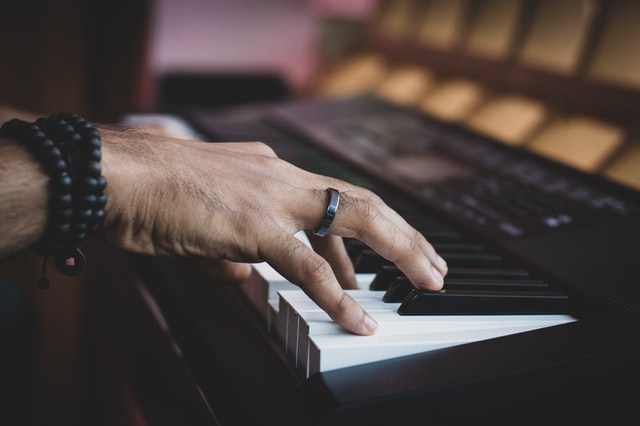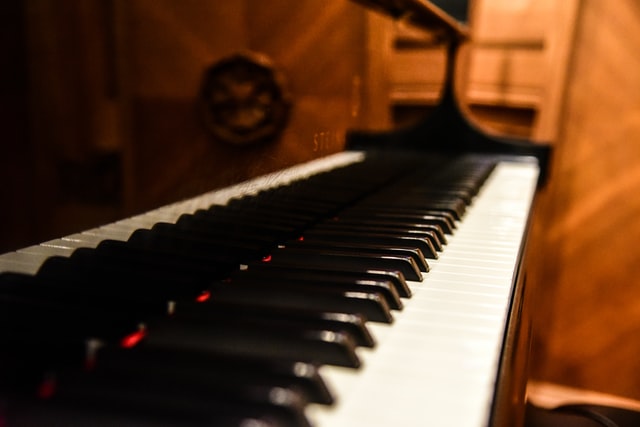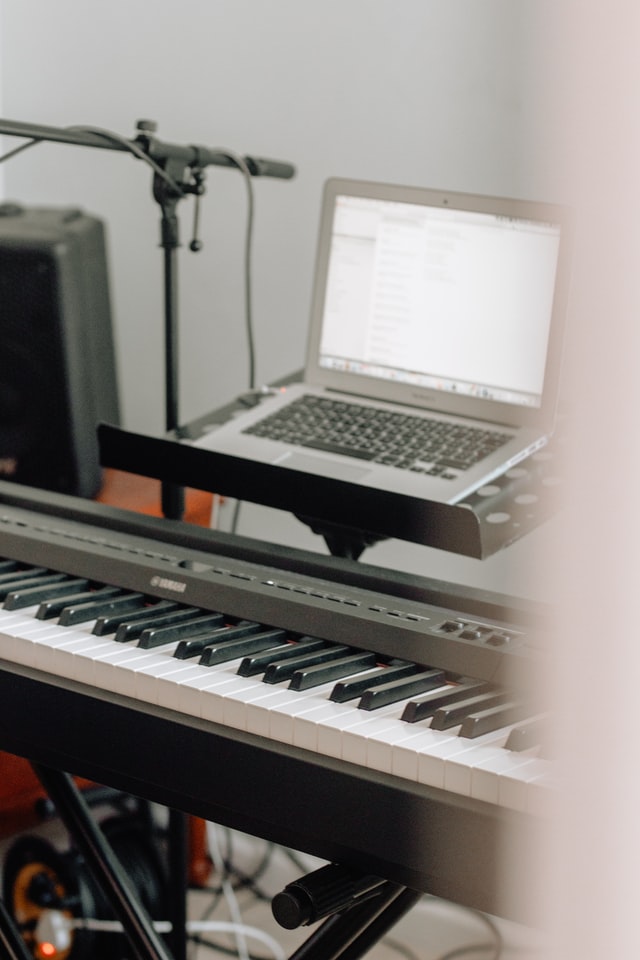How to choose a digital piano. The digital piano has become so much more popular in recent years, it gives so many of the benefits that an acoustic piano would but also comes with added convenience and portability.
Because of this growth in popularity, there are now a lot of options on the market. Some of these are from world-renowned brands such as Yamaha, but plenty of smaller brands have been cropping up too. It can be hard to choose a digital piano if you haven’t properly educated yourself and fully understood the features and functions. That’s where our guide comes in!
As well as looking at all of the features and the things that should play a part in your buying decision, we’re looking at digital piano reviews and establishing how you can find reliable reviews once you’ve narrowed it down to a couple of options. Too many online reviews are overly favorable because whoever writes them wants you to buy the product, so how do you get the real story and choose a digital piano that is perfect for you?
Choose a Digital Piano Based on Your Learning Stage
Have you ever head the phrase “all the gear and no idea?” This is so often applicable to piano learners. Some people go all out when it comes to buying equipment, spend a fortune, and then never get to a decent level of ability. Don’t let this happen to you.
Again, a lot of the biased piano reviews you see online will try and get you to choose a digital piano that is expensive, and this means more commission if they refer you to a retailer and you buy.
Admittedly, there is a big element of getting what you pay for in the music equipment industry. If you don’t part with much cash then don’t expect to get all of the top features, but you can still buy a great beginner digital piano and not have to spend thousands.
This is why it is so important to match up the digital piano you are going to buy with your ability level. If you’re an absolute newbie, why spend thousands on a top of the range digital piano when a beginner model can do everything you need it to?
Your learning stage is also important when you are deciding upon what features you need the digital piano to have. We recommend that every beginner opts for something with USB-MIDI compatibility. This allows you to make use of interactive online piano lessons. Your digital piano links in with our academy and allows you to take lessons with interactive feedback, telling you when you make a mistake or when you manage to play the song perfectly. For those who want a way to teach themselves the piano, this is invaluable.
Some digital pianos have learning features included such as lighting keys which show you the next note to play. There are differing opinions on how useful this is, but some of the top brands also include their own lesson systems to help teach you some songs. Usually, this is nowhere near a substitute for a full piano course or piano lessons, but if you want to choose a digital piano that can help you to learn more, it’s worth thinking about.
Number of Keys
The vast majority of digital piano options come with the same number of keys; 88. This is considered to be the “full” range for digital pianos (and for acoustic pianos, too). It’s been that way for hundreds of years.
This range allows you to play virtually any composition out there, whether you want to learn renditions of Beethoven or you’re happy playing some Beyonce tunes. It’s really up to you whether you take the simpler, rock and pop approach or you opt for more classical playing.
It should be said that if you are going to opt for classical training and look to use the full range of the digital piano, then you should stick with 88 keys rather than going for any of the smaller options.
What are the smaller options? When you’re looking to choose a digital piano you might notice a lot of 61-key models being advertised. Naturally, these are far more portable, and easy to take from place to place. 61 keys still allow you to play with two hands, which is one of the most important skills to master. Not a lot of songs sound particularly good with just one hand.
If you’re into rock and pop and want to play with more of a keyboard style, 61-keys could be enough. In the majority of instances though, it’s good to have that little bit extra just in case you should need it. This is one of the key factors when you choose a digital piano and it is not ideal to make the wrong choice and regret it at a later date.
Brand
This is an interesting consideration. We can’t deny that there are certain advantages to going with a bigger brand, and one that you have already heard of. Some of the biggest brands such as Yamaha and Casio offer the following advantages:
- Bigger product ranges. You can choose between far more products than most other music brands.
- Better support. This applies to needing to contact the company and also finding information online, such as YouTube videos for setting up your digital piano.
- Warranties. These aren’t exclusive to the bigger brands, but it is likely that you will find better warranties if you stick to the well-known brands.
- Experience. There’s a reason why these brands are elite, and have such big ranges, the experience they have from making thousands of digital pianos over the years means that they are less prone to having things go wrong.
What’s the difference between Yamaha and Casio?
This is a question that we come across time and time again. Yamaha and Casio are two of the powerhouse brands, but what makes them different? Well, as a generalization, Yamaha models tend to be a little more expensive, but many claim that their sound engine is better than Casio.
Conversely, Casio’s digital pianos may have more of a “keyboard” feel to them, but they are very good in terms of value for money. This all goes to prove a general point, that while the brand is important to some people, it shouldn’t be your number one consideration.
Whether Yamaha digital pianos or Casio are better is something that could be debated for hours, but the truth is that both have some brilliant options for people looking to choose a digital piano suitable for them.
Plenty of budget brands have entered the market, too. there are some more affordable models on the list but one of the sacrifices you need to make is to not have a product made by one of these bigger brands.
Alesis is an example of a great budget brand, and though you’re less likely to see their digital pianos played by wannabe classical musicians they give a good beginner option. If that’s what you’re looking for, there’s no reason not to go for a brand that is lesser known in order to save some money. Just ensure that the reviews are favorable. This leads us nicely onto the next point…
Digital Piano Reviews – Which Reviews to Trust?
The internet is awash with reviews of pretty much any product you can imagine. There is no problem looking for instrument reviews online, but be sure that the source is reliable and that they’re not pushy in terms of trying to get you to buy. Know Your Instrument is an example of a site that dedicates a lot of time to their research.
When you are reading “independent” online reviews that you have found through a search engine, consider if the article has a lot of well thought out information or it is just trying to make you buy something quickly. Well-written reviews of instruments usually cover all the bases, and can be thousands of words! Some of the reviews online are not really reviews so much as summaries of what other reviewers are saying. This might be useful, but it also might lead to bad buying decisions if the article hasn’t considered all the facts.
Check that any review you are reading has accurate information when compared to product listings and the manufacturer’s site. If you can check out a video review, unboxing or another way to check that the reviewer has played the product then this is a bonus.
This is an example of a review that actually talks you through the features but shows the piano in action. It’s a good way to get an idea of whether or not it is the sound and design you want when it is time to choose a digital piano. It’s also really helpful to get a grasp on size, for example. This can be quite an abstract concept. If a digital piano’s product listing says it is 25 lbs and gives a measurement in inches, it can be hard to establish size and weight just from that without getting a tape measure out.
The final thing to remember in the world of online reviews is the blessing of the huge platforms we have for people to buy, sell and leave reviews. Amazon may not be a specialist music store, but they sell a lot of musical instruments. Some of their digital piano options have hundreds of reviews.
When reading the reviews, you should be able to get a general consensus of opinions. Don’t purely judge on star ratings (though the star ratings do give a helpful indicator). Actually, it is best to read multiple reviews, both good and bad. A lot of Amazon reviewers will have a “verified purchase” badge (so you know they really bought it) and a lot break down their reviews into pros and cons. Try not to get drawn into reviews that discuss things like shipping problems. Sometimes, the one star reviews are moaning about a courier who has nothing to do with the digital piano itself.
Budget – Should I Choose a Digital Piano on Price?
We’ve already briefly covered some of the inevitable price considerations when buying a digital piano. Not many people are in the fortunate position where it really doesn’t matter what they spend, so most of us have some consideration of the cost.
If you are looking for a digital piano for beginners then you might be able to find something that is in the $300-500 range. This includes some of the budget Casio and Yamaha models, and also the Alesis Recital models, which are extremely popular for those on a budget. They don’t feel as professional as some of the more elite models, but that doesn’t mean they should be discounted. If you have no reference of playing other pianos then they won’t be a disappointment.
In the midrange we have around $500-1000 pianos. In this range, you can often choose between two types of digital piano:
- Stage pianos. These are small and compact, like a wider version of a keyboard. They replicate the keys of an acoustic piano, but at a small fraction of the size and weight.
- Console pianos. These are designed to look as much like acoustic pianos. The actual digital piano sits inside a stand or “console”. At a quick glance, you might not even think there was any difference between an acoustic and a console piano. They’re not as portable, but they are great for keeping in one spot within your home and can provide a decorative piece as well as being functional.
At this sort of price range you can get some very high-standard pianos that are suitable for gigging and recording as well as playing live.
At $1000 or over a lot of the pianos on the market are very professional. If you have years of experience playing and you want a pro feel to your instrument then this might well be the way to go. The goal for these sorts of digital pianos is to feel as much like an acoustic as possible, while retaining the advantages of a digital piano. Spending this sort of money gets you a pretty faithful replication.
Other Vital Features of Digital Pianos
Sound Engine
Just as an engine is vital to a car, it’s certainly vital to a digital piano! A sound engine is what produces the sound. These sound engines can be thought of as mini computers within your digital piano, and their job is to store the samples and trigger them when a note is hit.
Better sound engines have a far more nuanced approach, and they can play different samples depending on how hard a note is hit, to faithfully replicate the way an acoustic piano would work.
Sound engines tend to be better if you go for a more mainstream brand. Yamaha has the benefit of samples from their range of acoustic pianos. These have been recorded and turned into an exceptional bank of sounds for you to use from your digital piano. You can create sounds that are virtually identical to those from some of the most valuable and impressive acoustic pianos in the world.
Another brand with excellent sound engines is Roland, which uses “SuperNATURAL” technology to give a more acoustic feel to their sounds.
Tied to the sound engine is also the number of sounds. A lot of digital pianos have only around 10-12 sounds, which doesn’t sound like a lot, but if they are high-enough quality then this is all you need.
Weighted Keys and “Hammer Action”.
This is arguably the most important feature. It’s usually what differentiates a digital piano from a keyboard. When you choose a digital piano, consider whether the end goal is to eventually move over to an acoustic model, and to be able to switch between acoustic and digital with ease. If you want the same action as acoustic then, it’s Hammertime!
Hammer action replicattes the feel of the keys and how they trigger louder sounds based on how hard they are pressed. In the mechanics of an acoustic piano, tiny hammers actually hit the strings to generate the sound. Hit harder, a louder tone with a sharper attack is sounded. The hammer action on a digital piano is able to create a very respectable approximation of this.
Did you know that you can even buy “graded hammer action” keyboards, which make the action lighter in the higher keys. This is pretty impressive, and shows just how realistic a digital piano can be.
Weighted and unweighted keys are compared in the below guide.
Compatibility
Always consider what you are going to do with your digital piano, and therefore what it needs to be compatible with. Are you looking to hook yourself up to a digital learning course such as Pianu? Make sure your digital piano has a USB-MIDI function and can be connected easily to your computer. Do you need to connect to a PA system? An aux output will be a very helpful addition to your digital piano.
Digital pianos have inputs too. Some may allow you to connect an aux cable from your device in order to play along with your favorite songs. Others may just have an input for a sustain pedal. Acoustic pianos have pedals, and digital pianos may also have these, allowing a “sustain” playing mode among others. Learn more about the pros and cons of pedals here.
Effects
Effects are seen by many piano players as an added bonus. You wouldn’t get effects if you were to just play an acoustic piano, so people might not expect them on their digital. However, they can add a new dimension to the way your piano sounds.
Effects such as reverbs and delays can give a real feeling of space to your playing. Not only are they fun to experiment with, effects can be really useful for recording projects, too.
You might find a few other features as discussed, such as learning modes and LCD displays. Every model is slightly different, but generally, these features are the main ones to consider before you make any purchase of a digital piano.
Why Choose a Digital Piano Over Acoustic?
There are bound to be a lot of people who are reading this, and are still on the fence about whether to get a digital piano or an acoustic piano.
Of course, we all know the first, most obvious issue, in that acoustic pianos are not very portable. They also take up a lot of space in your home. Whereas a digital piano can potentially be stored away somewhere neatly, an acoustic needs a permanent home in your house. It’s literally part of the furniture.
There are other advantages to a digital piano, besides portability:
- Tuning. Digital pianos do not need to be tuned they are perfectly in tune and shouldn’t lose this over time, either.
- Compatibility. They’re much easier to record and use to control other music equipment. Digital pianos are designed for modern studio setups.
- Sounds. An acoustic piano can only really make one sound with some subtle variations. A digital can be programmed with many different sounds.
Acoustic pianos can often be picked up on eBay or other selling sites. They’re often affordable as people want to shift them. A simple upright piano might not cost a great deal. However, be warned. You might end up with something that sounds like the video below!
Conclusion
A lot of people who are in the market for a digital piano are not quite sure of what they are looking for. If it is your first purchase and you are a beginner then the idea of buying a digital piano might be challenging, especially with so much choice on the market.
To properly choose a digital piano for you, it is vital that you consider all of the different features and functions you require, as well as establishing your budget. You don’t want to spend a fortune only to discover that the piano you’ve purchased wasn’t a good fit.
Let your friends know about us.
Leave a Reply
You must be logged in to post a comment.













“How to Choose a Digital Piano – The Best Digital Options for Learning” is a great article. Thanks!